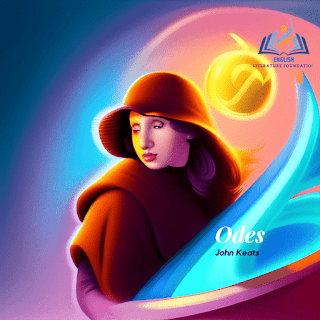Odes by John Keats: A Comprehensive Summary
Overview
John Keats, the renowned English poet of the Romantic era,
is celebrated for his unique poetic style and profound sensibility. He was a
master of the ode form, and his six great odes are widely considered among the
finest examples of this poetic genre. In this article, we will provide a
comprehensive overview of Keats's odes, exploring their themes, imagery, and
structure, and analyzing their impact on the literary world.
Introduction
John Keats's odes were written during the last years of his
life, from 1818 to 1819. These six poems – "Ode to a Nightingale,"
"Ode on a Grecian Urn," "Ode on Indolence," "Ode on
Melancholy," "To Autumn," and "Ode to Psyche" – are
widely considered among the greatest achievements of English Romantic poetry.
Keats's odes are known for their rich imagery, musicality, and emotional depth,
and they remain an enduring influence on poets and readers alike.
Background
Before diving into the individual odes, it is important to
understand the context in which they were written. Keats was born in London in
1795 and was apprenticed to a surgeon at the age of 15. However, he soon abandoned
this profession to pursue his love of literature and poetry. Keats's early
poems were not well received by critics, and he struggled financially
throughout his life. He suffered from poor health, and in 1821, at the age of
just 25, he died of tuberculosis.
Ode to a Nightingale
"Ode to a Nightingale" is perhaps Keats's most
famous ode. It is a meditation on mortality, beauty, and the power of art to
transcend the limitations of the human condition. The poem is structured around
the contrast between the fleeting nature of human life and the eternal song of
the nightingale. The poem's themes are expressed through a series of vivid
images and metaphors, which combine to create a powerful emotional impact.
Ode on a Grecian Urn
"Ode on a Grecian Urn" is another of Keats's most
famous odes. The poem is an exploration of the nature of beauty and art, and it
is structured around a meditation on a classical Greek urn. The urn serves as a
symbol of the eternal nature of art and the power of the imagination to create
lasting beauty. The poem's themes are expressed through a series of contrasts
between the static nature of the urn and the dynamic nature of human life.
Ode on Indolence
"Ode on Indolence" is a more personal and
introspective ode than Keats's other works. It is a meditation on the nature of
creativity and the difficulty of achieving true artistic inspiration. The poem
is structured around the contrast between the "sensual" pleasures of
indolence and the more transcendent pleasures of creative inspiration. The
poem's themes are expressed through a series of rich and evocative images,
which explore the complex interplay between the sensual and the spiritual.
Ode on Melancholy
"Ode on Melancholy" is another of Keats's
meditations on the human condition. The poem explores the nature of melancholy
– a feeling that is both painful and profound – and it is structured around a
series of contrasts between joy and sorrow, life and death. The poem's themes
are expressed through a series of vivid and evocative images, which combine to
create a powerful emotional impact.
To Autumn
"To Autumn" is perhaps Keats's most famous
seasonal ode. It is a meditation on the beauty and transience of autumn, and it
is structured around a series of vivid images that capture the essence of the
season. The poem celebrates the bountiful harvest and the changing colors of
the leaves, but it also acknowledges the inevitable decay and decline that come
with the changing of the seasons. The poem's themes are expressed through a
series of evocative and sensory images that create a powerful emotional impact.
Ode to Psyche
"Ode to Psyche" is Keats's first ode, and it is a
meditation on the power of the imagination and the human capacity for
transcendence. The poem is structured around a mythical figure – Psyche, the
goddess of the soul – and it explores the relationship between the physical and
spiritual realms. The poem's themes are expressed through a series of rich and
evocative images, which combine to create a powerful emotional impact.
Themes and Motifs
Keats's odes are known for their rich themes and motifs. One
of the most prominent themes in his poetry is the exploration of the human
condition – the joys and sorrows, the beauty and transience of life. Keats was
also interested in the power of the imagination and the human capacity for
transcendence. His odes often explore the relationship between the physical and
spiritual realms, and they celebrate the transformative power of art.
Another important motif in Keats's odes is the celebration
of beauty – the beauty of nature, of art, of the human form. Keats was a master
of sensory imagery, and his poems are filled with vivid descriptions of the
world around him. His odes also explore the relationship between beauty and
mortality – the idea that beauty is fleeting and transient, but that it can
also be a source of solace and inspiration in the face of death.
Structure and Style
Keats's odes are known for their intricate structure and
musicality. They are typically written in ten-line stanzas, with a rhyme scheme
of ABABCDECDE. The poems often begin with a statement or question, which is
then explored through a series of rich and evocative images. The odes also make
use of a variety of poetic devices, including alliteration, assonance, and repetition.
Impact and Legacy
Keats's odes had a profound impact on the literary world,
and they remain an enduring influence on poets and readers today. His use of
sensory imagery and his exploration of complex themes and motifs have made his
odes some of the most celebrated works of English Romantic poetry. Keats's
influence can be seen in the work of many later poets, including T.S. Eliot,
W.B. Yeats, and Wallace Stevens.
Conclusion
John Keats's odes are some of the most celebrated works of
English Romantic poetry. Through their rich themes, vivid imagery, and
intricate structure, they explore the human condition and celebrate the
transformative power of art. Keats's influence can be seen in the work of many
later poets, and his odes remain an enduring source of inspiration and beauty.
FAQs
- What
is an ode in poetry? An ode is a type of poem that is characterized by its
elaborate structure, rich imagery, and formal language. It is typically
written in praise of a person, place, or thing, and it often explores complex
themes and motifs.
- What
are the six great odes of John Keats? The six great odes of John Keats are
"Ode to a Nightingale," "Ode on a Grecian Urn,"
"Ode on Indolence

